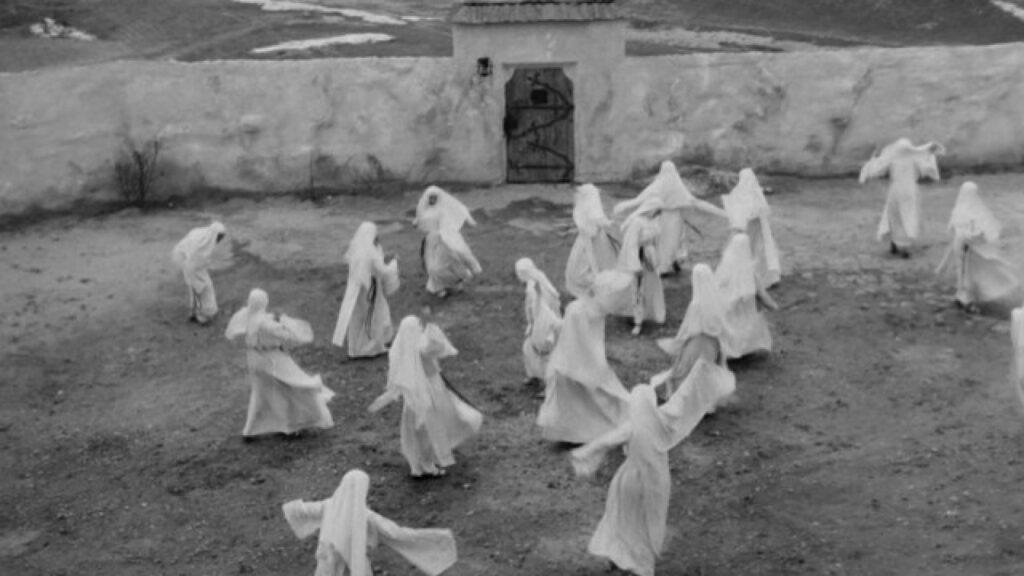
Set in the seventeenth century, Matka Joanna od Aniołów (1961) tells the story of a convent in rural Poland overrun with demonic possessions. The Reverend Mother Joan of the Angels (Lucyna Winnicka) is possessed by no fewer than a half-dozen demons. The Catholic church had already dispatched six priests to over see the exorcisms of the nuns when Father Jozef Suryn (Mieczyslaw Voit) arrives.
Filmmaker Jerzy Kawalerowicz’s adaptation of Jarosław Iwaszkiewicz’s novel of the same name is highly critical not just of Catholic doctrines but of spirituality in general. Though Matka Joanna od Aniołów pre-dates The Devils (1971) and Behind Convent Walls (1978) it nonetheless characterizes the demons who have possessed nuns as a self-awareness that is explained externally in theological terms. The devil that preys upon the faithful in these films is in actuality a sudden revelation of self that is inherently at odds with Catholic doctrines.
For Kawalerowicz the institutions of Catholicism and Judaism are interchangeable political complexes that exert control over the masses via spiritual manipulation. Kawalerowicz makes this explicit in the scene where Father Jozef Suryn goes to see the Rabbi only to find a reflection of himself. Voit plays both characters, making their duality physical as well as philosophical. It is this scene that equates the devil with the id.
This moment of clarity helps make sense of the scene in which Father Suryn first encounters Mother Joan. During a balletic fit Mother Joan states that the demon Balaam resides in her head while the demon Gressil hides in her stomach. Balaam, an Old Testament figure, corrupted the Israelites with sexual temptations that resulted in God’s wrath in the form of a plague in the Book Of Numbers. Gressil, a fallen seraphim of the Throne classification, comes from Sebastien Michaelis’ Admirable History and is said to tempt the devout with impurity. The physical location and theological significance of these demons in Mother Joan’s person reinforces the notion that possession was nothing more than a spiritual liberty; a break from and rebellion against the moral structures of religion.
Matka Joanna od Aniołów owes much of its style to Carl Theodor Dreyer’s Day Of Wrath (1943). Both Kawalerowicz and Dreyer were deeply spiritual artists who found in history a means of exploring their own internal theological conflicts. Black and white cinematography, an attention to historical detail and an embrace of on-screen silence characterize both films even while Kawalerowicz’s discourse is more explicitly focused on Catholicism. It is here that the films deviate in their similarities. Dreyer is not as overtly political in his scrutiny of religion to criticize the Catholic church as directly as Kawalerowicz.
Kawalerowicz’s political radicalism characterized his tenure as head of the Studio Filmowe Kadr. Like Matka Joanna od Aniołów, the films that Kawalerowicz helped bring to fruition at Kadr were aesthetically modernist and politically opposed to the Soviet state. As a member of the Polska Szkoła Filmowa Kawalerowicz equated technical and aesthetic innovation and experimentation with political resistance. Kawalerowicz brings all of this to bear in his direction of Matka Joanna od Aniołów while he also finds a unique sort of kinship between himself, the Polska Szkoła Filmowa and Mother Joan and her nuns.
Of the films inspired by or based upon the events of 1634 at the convent of the Order Of Saint Ursuline in Loudon, France, Matka Joanna od Aniołów is the most nuanced in its approach to the institutionally oppressive experiences of the nuns themselves as well as the ramifications of that oppression. The sensationalism of The Devils is no where to be found in Matka Joanna od Aniołów where the focus turns instead to internal questions of piety versus identity. What makes the bloody climax of Matka Joanna od Aniołów so terrifying is that the violence is borne out of a need for love rather than fear.
